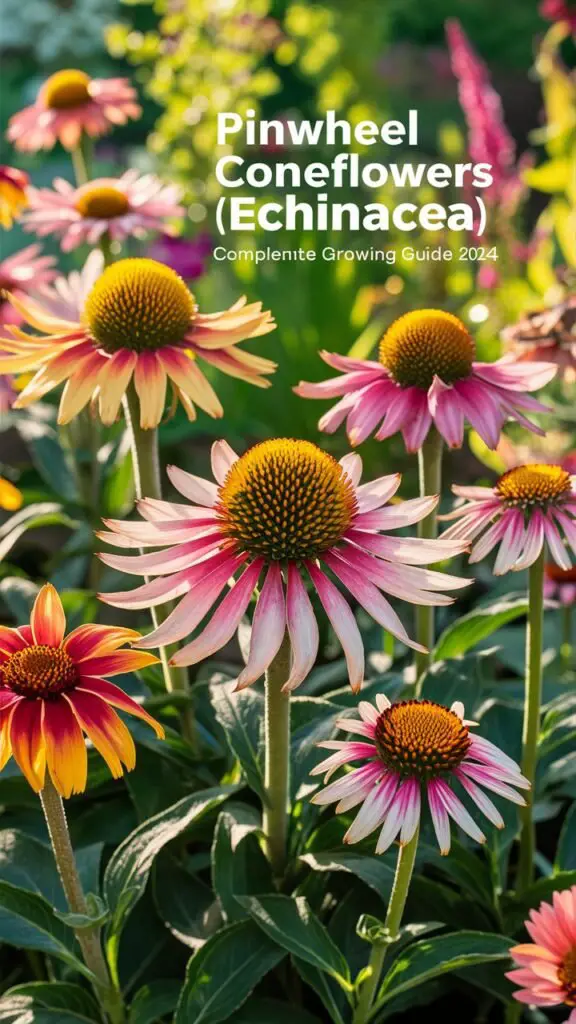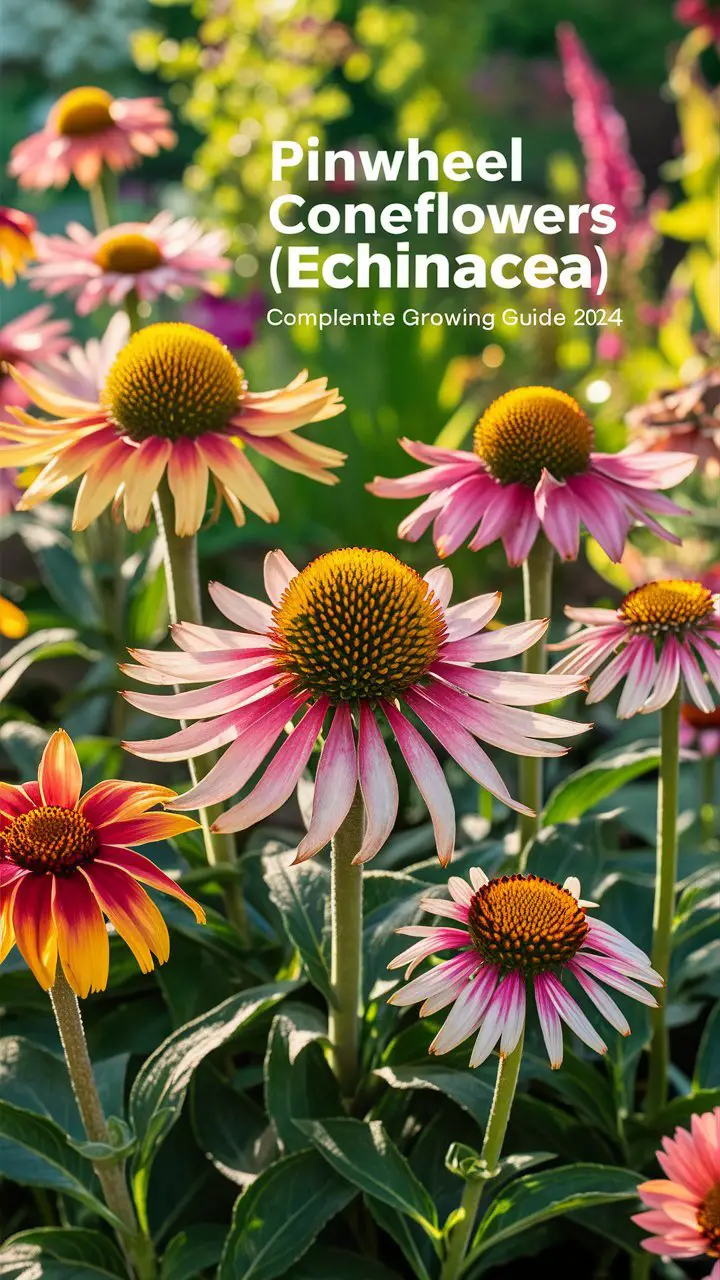Discover everything about the Pinwheel Coneflower—from planting tips to its uses. Ashley Scott shares 10 years of gardening know-how for USA growers!

Hey there, gardening friends! I’m Ashley Scott, and I’ve been messing around with plants for over 10 years now. One of my absolute favorites is the Pinwheel Coneflower (Echinacea). Picture this: a flower that looks like it’s twirling in the wind, with petals fanned out like a pinwheel. That’s the charm of this beauty! It’s caught my eye—and my heart—ever since I first planted it in my garden. In this guide, I’m spilling all the dirt (pun intended) on what makes this plant special, how to grow it, and why it’s a must-have for any gardener in the USA.
Whether you’re new to gardening or a seasoned pro, stick with me—I’ll walk you through everything you need to know about the Pinwheel Coneflower, from its roots to its blooms.
What is the Pinwheel Coneflower (Echinacea)?

The Pinwheel Coneflower (Echinacea) is a standout variety of the Echinacea genus, a group of plants native to North America. It’s part of the Asteraceae family, which you might know better as the daisy family. What makes this coneflower special? It’s all in the petals. Unlike your typical coneflower with droopy petals, the Pinwheel Coneflower has petals arranged in a whorled, pinwheel-like pattern. It’s almost like nature decided to give it a little extra flair!
I’ll never forget the first time I saw one in bloom. I’d just planted it in my backyard, and within weeks, it was stealing the show. The vibrant purple-pink flowers (though colors can vary) popped against the green foliage, and soon enough, butterflies and bees were all over it. It’s not just a plant—it’s a conversation starter.
Botanical Information: Digging into the Details
Let’s get nerdy for a minute and talk science. Here’s the lowdown on the Pinwheel Coneflower:
- Scientific Name: Echinacea purpurea ‘Pinwheel’ (the ‘Pinwheel’ part is the cultivar name, which can differ depending on the specific variety).
- Family: Asteraceae.
- Common Names: The species Echinacea purpurea is widely known as the purple coneflower, but this cultivar goes by Pinwheel Coneflower or sometimes just Pinwheel Flower.
- Native Range: Echinacea hails from the central and eastern United States.
- Hardiness Zones: It thrives in USDA zones 3-9, so it’s perfect for most American gardens.
This perennial grows to about 2-3 feet tall and spreads 1-2 feet wide. It dies back in winter but bounces back each spring with gusto. Want to geek out more? Check out this botanical overview from the Missouri Botanical Garden.
Growing and Caring for Pinwheel Coneflower
Good news: the Pinwheel Coneflower isn’t fussy. With a little know-how, you can grow it like a pro. Here’s how I’ve kept mine thriving for years:
Planting Pinwheel Coneflower
- Timing: Plant in spring after the last frost or in early fall.
- Location: Pick a sunny spot with at least 6 hours of direct sunlight. It can handle some shade, but full sun is its happy place.
- Soil: Go for well-drained soil. If it’s too wet, the roots will sulk. I’ve had success mixing in compost if my soil’s too heavy.
- Steps:
- Dig a hole twice as wide as the root ball.
- Pop the plant in, keeping the top of the root ball level with the soil.
- Fill it in, pat it down, and give it a good drink.
- Space plants 18-24 inches apart—they like their elbow room!
Starting from seeds? You can sow Pinwheel Coneflower Echinacea seeds directly outside after frost danger passes or kick things off indoors 8-10 weeks earlier. Need a seed-starting refresher? I’ve got you covered with my guide on starting seeds indoors.
Watering and Fertilizing
- Watering: Keep the soil moist while the plant settles in. Once it’s established, it’s pretty drought-tolerant—perfect for those hot summer days when I forget to water!
- Fertilizing: Less is more here. Too much fertilizer makes it leggy. I toss some compost around mine in spring, and that’s it.
Pruning and Maintenance
- Deadheading: Snip off faded blooms to keep the flowers coming. I cut back to a leaf node—it’s like giving the plant a little pep talk.
- Dividing: Every 3-4 years, I dig up and split mature clumps to keep them healthy. Spring or fall works best.
- Winter Prep: In colder zones, I leave the dried heads on for the birds (and because they look cool covered in snow). Come spring, I trim back the dead stuff.
For more care tips, this University of Minnesota Extension page is a goldmine.
Uses of Pinwheel Coneflower
The Pinwheel Coneflower isn’t just a pretty face—it’s got purpose too. Here’s how I’ve put it to work:
Ornamental Uses
- Garden Star: Its bold blooms shine in borders, wildflower patches, or as a standalone stunner.
- Pollinator Party: Bees and butterflies can’t get enough of it. My garden’s buzzing all summer thanks to this plant!
- Cut Flowers: Those sturdy stems make gorgeous bouquets that last ages in a vase.
Want more pollinator action? Peek at my post on creating a pollinator-friendly garden.
Medicinal Uses
Now, here’s where it gets interesting. While I grow the Pinwheel Coneflower mostly for looks, its cousin Echinacea purpurea has a rep for health benefits. People have used it for ages to boost immunity and fend off colds. You can brew teas or make tinctures from the roots, leaves, or flowers.
That said, the Pinwheel Coneflower Echinacea uses for medicine aren’t as well-documented—it’s a cultivar, after all. If you’re serious about herbal remedies, stick with standard purple coneflower uses or chat with a herbalist. Curious? The National Center for Complementary and Integrative Health has the scoop.
Frequently Asked Questions
Got questions? I’ve got answers! These are the ones I hear most about the Pinwheel Coneflower:
What’s the difference between Pinwheel Coneflower and other Echinacea varieties?
It’s all about the petals. The Pinwheel Coneflower has that whorled, pinwheel look, while most coneflowers have droopy petals. It’s like comparing a twirly skirt to a straight one—both cute, just different styles!
Can I grow Pinwheel Coneflower from seeds?
Yep! Sow Pinwheel Coneflower Echinacea seeds outdoors post-frost or start them inside earlier. Note: since it’s a cultivar, seed-grown plants might not match the parent exactly.
Is Pinwheel Coneflower deer-resistant?
Mostly, yes. Deer don’t love Echinacea’s texture or taste, but hungry ones might still nibble. I’ve been lucky in my yard, though!
How tall does Pinwheel Coneflower grow?
Expect 2-3 feet tall and 1-2 feet wide—nice and compact.
When does Pinwheel Coneflower bloom?
It struts its stuff from mid-summer to early fall, giving you months of color.
For more gardening Q&As, swing by USA Garden Hub.
Wrapping It Up
The Pinwheel Coneflower (Echinacea) is a total win for any garden. It’s easy to grow, gorgeous to look at, and brings all the pollinators to the yard. After a decade of gardening, I can say it’s one of my top picks—especially when I see those butterflies dancing around it every summer.
Ready to plant your own? I’d love to hear how it goes—or if you’ve already got one, tell me your story in the comments! Happy digging, friends!





7 Comments on “Pinwheel Coneflower (Echinacea): Your Complete Guide to Growing and Caring for This Unique Plant”